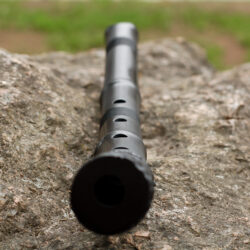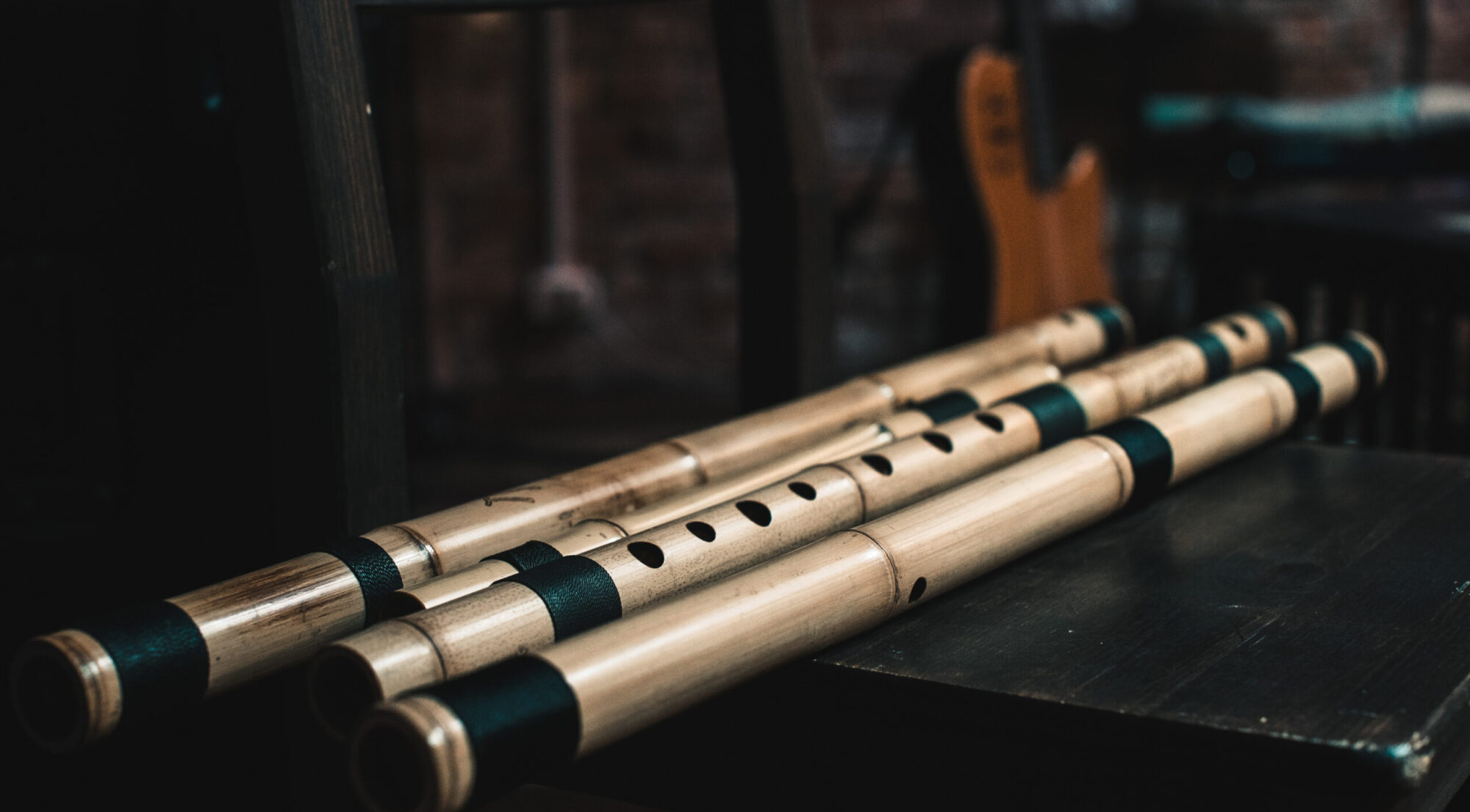-
 Shakuhachi 1.8 (D4 440Hz) jiari root-end€240.00
Shakuhachi 1.8 (D4 440Hz) jiari root-end€240.00 -
 Shakuhachi root-end (black)€225.00 – €245.00
Shakuhachi root-end (black)€225.00 – €245.00 -
 Shakuhachi root-end€225.00 – €260.00
Shakuhachi root-end€225.00 – €260.00
One of the most famous ethnic flutes in the world and also may be the most complex one in the universe. Practicing playing shakuhachi can be a lifelong project and journey. There is a near infinite number of nuances to the shakuhachi which also has a long and rich tradition you can endlessly explore.
Shakuhachi is used both as a musical instrument and as an instrument for meditation practice and prayer (and everything in between). It is believed that medieval Japanese Zen buddhist monks (called komuso monks from the Fuke sect of Zen Buddhism) used their flutes as clubs to defend themselves from robbers when they were on a pilgrimage or begging for alms (never use a flute as a club!). It is a very multifunctional object with a rich historical and cultural background.
Each Shakuhachi flute is different as are flutes made by different masters. Before I start working on a shakuhachi for you, I often like to know as much as possible about your previous experiences, expectations, goals, and visions of music and/or music practice. No shakuhachi are exactly identical.
The sound of a Shakuhachi
Shakuhachi has a natural windy sound and as many describe a “breathy” rich tone. Shakuhachi could produce loud and screechy or raw, soft and relaxing sounds. In medieval Japan, monks were mostly former samurai (ronin) that lost their jobs and could not find a Shogun to be employed under. If their clan were defeated by another clan some of the shogun either committed seppuku or were killed by other samurai leaving all of their hired samurai unemployed. Ronin sometimes ended up becoming robbers, or took contract jobs as guards or assassins. Some became monks who begged for alms. One special kind of monk was komuso. These komuso monks played shakuhachi as a way for prayer and breathing meditation (suizen) and often played along roads and towns for alms. The komuso were famous for wearing a straw weaved hat called a “Tengai” which concealed their identity. By concealing their faces their egos were also empty. This is a similar practice in Zen Buddhist temples where monks meditate in front of a blank wall. The goal is to embrace emptiness. The komuso played flutes that were mostly not in tune because their shakuhachi were not musical instruments but were meant to be used as a spiritual tool. It was later when the shakuhachi slowly started evolving into the kind of shakuhachi used today. Overall, the komuso had a great influence on the cultural and musical tradition behind the Shakuhachi. My favorite quote is “the sound of shakuhachi underscores the sound of void between the notes.”
Jinashi and Jiari
There are two kinds of Shakuhachi: Jinashi and Jiari.
Jinashi (meaning “without Ji”) are flutes with an internal bore that is most natural to the bamboo. Some Jinashi known as “Hocchiku” or “Hotchiku” named by Watazumi Doso (meaning “Dharma Bamboo”) are Jinashi flutes with a bore that is totally raw and unlacquered and the only way that it is tuned is by shaving off the nodes on the inside. These flutes are very hard to come by because it requires flute makers to be at the mercy of nature and find the right bamboo that is closest to the requirements that would make it be tuned. To make life slightly easier for flute makers, most Jinashi flutes have a thin layer of urushi lacquer used for tuning purposes as well as providing protection to the bore from mold and moisture damage. In general, they are characterized by a softer, windier, and rich sound most similar to how a piece of dense bamboo in nature would sound. It is sometimes impossible to perfectly tune a jinashi flute because the methods for making Jinashi shakuhachi are not that invasive to the bamboo’s natural form. This way we get to experience the rawness and authenticity of the bamboo. It is common to prefer the Jinashi flute for suizen meditation practice. Usually Jinashi Shakuhachi have no horn or bone inlay. But some Jinashi would have an inlay and could be quite loud.
Jiari (meaning “with Ji”) shakuhachi are flutes with a bore that may or may not be too favored in the dimensions required to be tuned. Therefore, there is more leeway to the choice of bamboo the maker wishes to make their shakuhachi with. The reason for this is because Jiari flutes are tuned in the bore with Ji paste (most recipes for Ji are tonoko powder, urushi lacquer, and water) which when dried turns into a smooth, hard, and shiny plaster. Overall, these flutes are much easier to tune because the methods for tuning Jiari Shakuhachi are more intrusive to the bamboo’s natural form and some may consider them more “man-made” and artificial. However, Jiari flutes create a louder and brighter sound which some are almost perfectly tuned. A well tuned Jiari could be used to play anything and at times be easier to hit higher octave notes due to the smooth and almost perfect ji tuning. They make great choices for concerts, playing in a band with other musicians, or even just solo playing and suizen meditation. You can say that Jiari flutes are very versatile. Jiari flutes almost always have a bone or horn inlay for more precise blowing.
In general, it is not necessary to stick to these extreme options, interesting results are often found somewhere in the middle. I usually proceed from the customer’s requests and from the specifics of a certain bamboo piece to find the “sweet spot.”
Utaguchi inlay
A flute may or may not have an Utaguchi inlay. As an option, I can make an Utaguchi inlay out of bone. The main purpose of the inlay is to make the thin playing edge more durable as well as making a clearer, cleaner, and accurate sound.
Traditionally, there are two kinds of inlay styles – Tozan and Kinko. The difference is only cosmetic and does not affect the sound.
I can also replace the utaguchi inlay on your flute. Email or message me to discuss the details.
Please be careful with the blowing edge of your shakuhachi! This is the most vulnerable part of the flute and once it is damaged or chipped it would be very difficult to make a sound.
Key/length of the flute
Komuso used shakuhachi as a spiritual tool for prayer and meditation and mostly played out of tune (to the Western ear). They identified their flutes by calling them by the length of the Shakuhachi. “Shaku” was a measurement system that the Japanese used to measure things. One “Shaku” was about 30.3 centimeters or a little under 12 inches or a foot. “Hachi” means eight “Sun” which is a little short of one inch. Therefore, one “Shaku” “Hachi” is equivalent to one foot – eight inches. However, the measurements back then were smaller and their “Shaku-Hachi” was equivalent to one foot – seven inches. Thus, their main flute was 1.7 whereas in modern day it is 1.8. During the Meiji Restoration when the Japanese adopted Western culture including Western music, Shakuhachi evolved to be “in tuned” to the Western ear. Therefore, Shakuhachi were later identified by their note. The traditional 1.8 shakuhachi is tuned to D.
Traditional VS custom options
Shakuhachi are made from bamboo which is created by nature. Because bamboo is natural they may come in all sizes, density, shapes, and cosmetic marks. Ex. bamboo with 6 nodes instead of 7. Therefore, it is extremely hard to find a piece that fulfills all the requirements perfectly and also has the right length, so you may have to give up on something
The traditional proportions.
Frankly, the sound and tone would not be affected if the piece of bamboo does not match with the traditional way, it is just a tradition but it is a beautiful tradition. The flute should have seven nodes, three at the bottom, one near the front of the first hole, one between the second and the third hole, one after the thumb hole, and one at the end. Usually, I make a flute in two or even three parts to make it both in the traditional proportions and fit the key. The splices between the parts are strong. If you want a one-piece flute to fit the traditional proportions and tuned exactly in the right key, let me know. This is an exquisite option and it may be much more expensive.
If a particular flute key is not very important, there are two options:
Any key with the precision of a half-tone. If you don’t mind a C# shaku, for example, or a B shaku. Creating these shakuhachi would be much easier. The simpler the key is, the more possibilities there are to work with the sound.
In general, any tuning without a particular choice of the key. The flute will be tuned “into itself”. It may be a good option if you do not plan to play with other musicians. That’s what they used to do in the good old days.
Shakuhachi aesthetics
Traditionally, shakuhachi are considered beautiful when they have thick walls and are made out of a massive piece of bamboo (within the traditional proportion, without excess). Small lateral roots at the flute’s end can be quite long, medium size (4-6 mm), and/or smoothly polished. A small bend in one plane is also appreciated.
In Japanese culture, there is a concept of wabi-sabi – imperfect beauty. It is very applicable to the aesthetics of the Shakuhachi – natural properties of bamboo, signs of aging, natural marks and spots, and odd shapes are not considered a defect.
If you want to choose bamboo for your flute yourself, message or email me about your preferences and I will offer you three pieces to choose from.
Bore finish
Traditionally, the inner bore is covered with red or black urushi lacquer. I prefer modern varnish as a more practical and cost efficient method. Please let me know if you are a fan of traditional technologies. For the jinashi flute, it is also possible to use transparent varnish to make it look natural.

